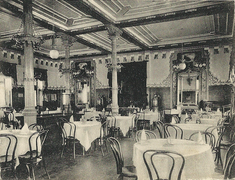Ludwigsbad
The former spa hotel Ludwigsbad in Bad Aibling was the first mud spa in Bavaria and the first saline mud spa in the world. It emerged from a "brine and mud bath" that Desiderius Beck founded in 1845 .
history
19th century
In 1845 Desiderius Beck opened the establishment in Aiblinger Rosengasse, initially as a one-story bathhouse, which was gradually expanded.
In the first half of the 19th century, the bath was the central point of Bad Aibling's health care activities, but nevertheless ran into economic difficulties. These were only resolved after the takeover by the entrepreneur Karl von Berüff. Later on, the spa business was continued, but at the same time increasing importance was attached to the activity as a grand hotel . The hotel was named Ludwigsbad in 1871 in honor of the King of Bavaria .
20th century
After the owner family got into debt, the Ludwigsbad had to be forcibly auctioned off in 1902. The entrepreneur and banker Ludwig Meggendorfer took over the traditional property. A generous renovation introduced what was, for the time, very modern technical equipment, including steam heating , electric light and water baths and shower rooms. Under the direction of the engineer von Hößle, a modern “bath house” was built, which was characterized by a mechanical mud bath preparation system based on the “Meggendorfersystem”, with which the consistency of the mud paste was optimized and at the same time disinfected.
In the following decades up to the First World War , the house flourished before it had to be sold in the economically difficult period of the 1920s . It was then owned by the city until 1936 , which sold it to the Antretter family, under whose leadership a new upswing was achieved that extended beyond the Second World War .
At the end of the 20th century the Ludwigsbad was stopped for economic reasons in the course of the decline of the spa.
Memorial plaque on the north wall of the former Hotel Ludwigsbad with a portrait of Dr. Desiderius Beck
21st century
On March 17, 2007 , the buildings were the target of an arson attack by two young people, which led to serious damage to the historic structures. The damage caused amounted to around € 750,000.00 to € 2 million.
At the end of 2008 it was initially uncertain whether the building could be preserved. After all, in November 2007, following political pressure from the city of Bad Aibling, protective scaffolding was installed on the owner of the fire ruins, and the re-roofing and securing of the outer walls against intrusion by unauthorized persons began. In July 2011, however, all the buildings were completely demolished so that a parking lot could be built there.
In the summer of 2017, the owner of the site presented the plans for a new development of the area. This will consist of six buildings, including a high-rise building 34 meters high.
Individual evidence
- ^ W. Keitz, B. Weigert. Bad Aibling. The spa town and its districts in words and pictures. Geiger-Verlag, Horb am Neckar, 1993. ISBN 3892648557
- ↑ a b "A world first at the time it was founded". Upper Bavarian Volksblatt. September 24, 2011. https://www.ovb-online.de/rosenheim/bad-aibling/gruendungszeit-eine-weltneuheit-1418813.html
- ↑ a b c Manfred Schaulies (2018): Meggendorfer family - history of a merchant family. The Mangfallgau 22: 64–195
- ↑ mangfall24.de: Eleven-story "high-rise" on the grounds of the Ludwigsbad?
Web links
- Entry to Ludwigsbad in the history of the city of Bad Aibling
- Article in Rosenheimer Nachrichten on the fire in the historic ensemble
- Report by the Upper Bavarian Volksblatt on the start of the security measures on the ruins
Coordinates: 47 ° 51 ′ 42.3 " N , 12 ° 0 ′ 44" E









